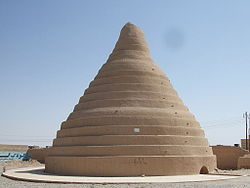
Yakhchal
Encyclopedia

In 400 BC Persian
Persian people
The Persian people are part of the Iranian peoples who speak the modern Persian language and closely akin Iranian dialects and languages. The origin of the ethnic Iranian/Persian peoples are traced to the Ancient Iranian peoples, who were part of the ancient Indo-Iranians and themselves part of...
engineers had already mastered the technique of storing ice in the middle of summer in the desert.
Above ground, the structure had a domed shape, but had a subterranean storage space; it was often used to store ice, but sometimes was used to store food as well. The subterranean space coupled with the thick heat-resistant construction material insulated the storage space year round. These structures were mainly built and used in Persia (Iran)
Iran
Iran , officially the Islamic Republic of Iran , is a country in Southern and Western Asia. The name "Iran" has been in use natively since the Sassanian era and came into use internationally in 1935, before which the country was known to the Western world as Persia...
. Many remain standing that were built hundreds of years ago.
History
By 400 BC, Persian engineers had mastered the technique of storing ice in the middle of summer in the desert. The ice could be brought in during the winters from nearby mountains. But more commonly they had a wall made along an east-west direction close to the Yakhchal. In winter, the QanatQanat
A qanāt is a water management system used to provide a reliable supply of water for human settlements and irrigation in hot, arid and semi-arid climates...
water was canalized to north side of the wall. The shadow of the wall made the water freeze more quickly so more ice was produced per winter day. Ice was stored in a specially designed, passively cooled refrigerator. This was a large underground space (up to 5,000 m³) that had thick walls (at least two meters at the base) made out of a special mortar called sārooj, composed of sand, clay, egg whites, lime, goat hair, and ash in specific proportions, and which was resistant to heat transfer. This mixture was thought to be completely water impenetrable. The space often had access to a Qanat, and often contained a system of windcatcher
Windcatcher
A windcatcher is a traditional Persian architectural device used for many centuries to create natural ventilation in buildings. It is not known who first invented the windcatcher, but it still can be seen in many countries today. Windcatchers come in various designs: uni-directional,...
s or Wind Towers that could easily bring temperatures inside the space down to frigid levels in summer days. The ice was then used to chill treats for royalty during hot summer days and to make faloodeh
Faloodeh
Fālūde or Pālūde is a Persian cold dessert made of thin vermicelli noodles with corn starch, rose water, lime juice, and often ground pistachios. It is a traditional dessert in Iran and Afghanistan. The faloodeh of Shiraz is especially famous....
, the traditional Persian frozen dessert.
Features
The Yakhchal in Kerman is located about a mile from the center of the city. This cone-shaped building is about sixty feet high. The massive insulation and the continuous cooling waters that spiral down its side keep the ice stored there in winter frozen throughout the summer. These ice houses used in desert towns from antiquity have a trench at the bottom to catch what water does melt from the ice and allow it to refreeze during the cold desert nights. The ice is broken up and moved to caverns deep in the ground. As more water runs into the trench the process is repeated. Often seen around the ice houses and many of the homes in the desert are towers called badgirs or wind traps. Built of mud or mud brick, these badgirs, mentioned by Marco PoloMarco Polo
Marco Polo was a Venetian merchant traveler from the Venetian Republic whose travels are recorded in Il Milione, a book which did much to introduce Europeans to Central Asia and China. He learned about trading whilst his father and uncle, Niccolò and Maffeo, travelled through Asia and apparently...
, are square or round, but the operating principle is the same: to catch the slightest breeze in the vents at the top and to funnel the cooling air down through internal, vertically-placed wooded slats to the water or dwelling below.
In present-day Iran, the term yakhchal is also used to refer to modern household (and commercial) refrigerators.
See also
- Ab AnbarAb AnbarAn āb anbār is a traditional reservoir or cistern of drinking water in Persian antiquity. The Persian phrase literally translates as "water reservoir".-The structure:...
- Windcatchers
- SoltaniyehSoltaniyehSoltaniyeh is a city in and capital of Soltaniyeh District of Abhar County, Zanjan Province, Iran. At the 2006 census, its population was 5,684, in 1,649 families. Soltaniyeh, located some to the north-west of Tehran, used to be the capital of Mongol Ilkhanid rulers of Persia in the 14th century....
- Traditional water sources of Persian antiquityTraditional water sources of Persian antiquityMost rivers in Iran are seasonal and have traditionally not been able to supply the needs of urban settlements. Major rivers like the Arvand, Aras, Zayandeh, Sefid and Atrak were few and far between in the vast lands of Persian antiquity....

